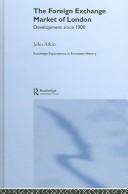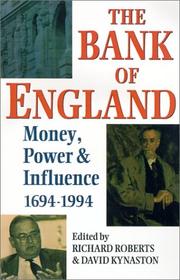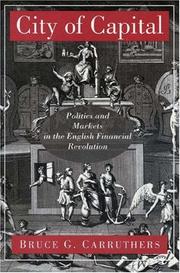| Listing 1 - 10 of 15 | << page >> |
Sort by
|
Book
ISBN: 1316530353 1107690862 Year: 2013 Publisher: Cambridge : Cambridge University Press,
Abstract | Keywords | Export | Availability | Bookmark
 Loading...
Loading...Choose an application
- Reference Manager
- EndNote
- RefWorks (Direct export to RefWorks)
Originally published in 1943, this book presents a rigorous study of central banking from both theoretical and historical perspectives during the period 1797 to 1913. This parallel treatment of monetary events and monetary theories reveals not only the connection between the facts and the theories, but also the occasional gaps between them. Numerous tables and an appendix section are also included. This book will be of value to anyone with an interest in the development of banking and economic history.
Banks and banking --- History. --- Bank of England. --- Governor and Company of the Bank of England --- Eiran Ginkō --- Old Lady of Threadneedle Street --- Old Lady in Threadneedle Street --- Great Britain.
Book
ISBN: 1139093622 1108035817 Year: 2012 Publisher: Cambridge : Cambridge University Press,
Abstract | Keywords | Export | Availability | Bookmark
 Loading...
Loading...Choose an application
- Reference Manager
- EndNote
- RefWorks (Direct export to RefWorks)
Walter Bagehot (1826-77), the influential political and economic essayist, wrote a number of books that became standards in their respective fields. He attended University College, London, where he studied mathematics and gained a master's degree in intellectual and moral philosophy. He was called to the bar, but instead chose a career in his father's banking business. He wrote widely on literature, economics and politics, co-founding the National Review in 1855. He became editor-in-chief of The Economist in 1860 and remained in that post until his death. This work, published originally in 1873 and described by J. M. Keynes as 'an undying classic', is a masterpiece of economics. It explains the world of finance and banking, concentrating on crisis management, and its ideas are as relevant today as ever, especially in the face of the global financial crisis that emerged in 2007.
Money market --- History --- Bank of England. --- Money markets --- Finance --- Financial institutions --- Money --- Governor and Company of the Bank of England --- Eiran Ginkō --- Old Lady of Threadneedle Street --- Old Lady in Threadneedle Street --- Great Britain.
Book
ISBN: 9781108835015 9781108799492 1108799493 9781108875189 1108835015 1108875181 1108892337 1108890695 Year: 2020 Publisher: Cambridge : Cambridge University Press,
Abstract | Keywords | Export | Availability | Bookmark
 Loading...
Loading...Choose an application
- Reference Manager
- EndNote
- RefWorks (Direct export to RefWorks)
Making a Modern Central Bank examines a revolution in monetary and economic policy. This authoritative guide explores how the Bank of England shifted its traditional mechanisms to accommodate a newly internationalized financial and economic system. The Bank's transformation into a modern inflation-targeting independent central bank allowed it to focus on a precisely defined task of monetary management, ensuring price stability. The reframing of the task of central banks, however, left them increasingly vulnerable to financial crisis. James vividly outlines and discusses significant historical developments in UK monetary policy, and his knowledge of modern European history adds rich context to archival research on the Bank of England's internal documents. A worthy continuation of the previous official histories of the Bank of England, this book also reckons with contemporary issues, shedding light on the origins of growing backlash against globalization and the European Union.
Banks and banking, Central --- Finance --- Globalization --- History --- Economic aspects --- Bank of England --- Banks and banking, Central - Great Britain - History --- Finance - Great Britain --- Globalization - Economic aspects --- Banker's banks --- Banks, Central --- Central banking --- Central banks --- Banks and banking --- History. --- Economic aspects. --- Governor and Company of the Bank of England --- Eiran Ginkō --- Old Lady of Threadneedle Street --- Old Lady in Threadneedle Street --- Great Britain.
Book
ISBN: 1107109922 1108068480 Year: 2014 Publisher: Cambridge : Cambridge University Press,
Abstract | Keywords | Export | Availability | Bookmark
 Loading...
Loading...Choose an application
- Reference Manager
- EndNote
- RefWorks (Direct export to RefWorks)
Prior to its publication in 1830, the draft of this work by Sir Henry Parnell, later Baron Congleton (1776-1842), was praised by John Stuart Mill, who said he could 'not see that it is possible to lay down the principles of political economy more broadly'. Chair of the select committee on public income and expenditure during the Duke of Wellington's first ministry, Parnell called for greater retrenchment and reduced taxation. He also argues here that 'the passage of merchandise from one state to another ... ought to be as free as air and water', denouncing the supporters of protection as 'among the greatest enemies of mankind'. A later pamphlet by Parnell, A Plain Statement of the Power of the Bank of England (1832), highly critical of the Bank's monopoly, is included in this reissue. His Treatise on Roads (1833) is reissued separately in the Cambridge Library Collection.
Finance, Public --- Banks and banking --- History --- Bank of England. --- Agricultural banks --- Banking --- Banking industry --- Commercial banks --- Depository institutions --- Finance --- Financial institutions --- Money --- Governor and Company of the Bank of England --- Eiran Ginkō --- Old Lady of Threadneedle Street --- Old Lady in Threadneedle Street --- Great Britain.
Book
ISBN: 1108605834 1108627390 110849983X 1108584306 Year: 2019 Publisher: Cambridge : Cambridge University Press,
Abstract | Keywords | Export | Availability | Bookmark
 Loading...
Loading...Choose an application
- Reference Manager
- EndNote
- RefWorks (Direct export to RefWorks)
The Bank of England and the Government Debt recounts the surprising history of the Bank of England's activities in the government securities market in the mid-twentieth century. The Bank's governor, Montagu Norman, had a decisive influence on government debt management policy until he retired in 1944, and established an auxiliary market in government securities outside the Stock Exchange during the Second World War. From the early 1950s, the Bank, concerned about inadequate market liquidity, became an increasingly active market-maker in government securities, rescuing the commercial market-makers in the Stock Exchange several times. The Bank's market-making activities often conflicted with its monetary policy objectives, and in 1971, it curtailed them substantially, while avoiding the damaging effects on liquidity in the government securities market that it had feared. Drawing heavily on archival research, William A. Allen sheds light on little-known aspects of central-banking and monetary policy.
Monetary policy --- Banks and banking, Central --- Debts, Public --- BUSINESS & ECONOMICS / Economics / Macroeconomics. --- Debts, Government --- Government debts --- National debts --- Public debt --- Public debts --- Sovereign debt --- Debt --- Bonds --- Deficit financing --- Banker's banks --- Banks, Central --- Central banking --- Central banks --- Banks and banking --- Monetary management --- Economic policy --- Currency boards --- Money supply --- History --- Bank of England --- Governor and Company of the Bank of England --- Eiran Ginkō --- Old Lady of Threadneedle Street --- Old Lady in Threadneedle Street --- Great Britain.

ISBN: 041534901X 0415647835 9786610225576 1134273959 1280225572 020332269X 9780203322697 9780415349017 9781134273904 1134273908 9781134273942 1134273940 9781134273959 9780415647830 9781280225574 6610225575 9781134273928 1134273924 Year: 2005 Publisher: London Routledge
Abstract | Keywords | Export | Availability | Bookmark
 Loading...
Loading...Choose an application
- Reference Manager
- EndNote
- RefWorks (Direct export to RefWorks)
Foreign Exchange is big business in the City of London. At the last official count, turnover on the London foreign exchange market averaged a staggering 504 billion a day. No other financial centre in the world even comes close to matching this total. Thirty one per cent of global foreign exchange activity takes place in the United Kingdom, compared with only sixteen per cent in the United States and nine per cent in Japan.However, this has not always been so. A hundred years ago, the London foreign exchange market played second fiddle to more important centres in New York, Paris an
Foreign exchange market --- -332.4509421 --- Exchange market --- Foreign exchange markets --- FX market --- Markets --- Bank of England. --- Governor and Company of the Bank of England --- Eiran Ginkō --- Old Lady of Threadneedle Street --- Old Lady in Threadneedle Street --- Great Britain. --- 339.74 <430> --- Monetaire buitenlandse politiek. Deviezenpolitiek--?<430> --- 339.74 <430> Monetaire buitenlandse politiek. Deviezenpolitiek--?<430> --- 331.162.1 --- GB / United Kingdom - Verenigd Koninkrijk - Royaume Uni --- 338 --- 338 Economische situatie. Economische structuur van bepaalde landen en gebieden. Economische geografie. Economische produktie.economische produkten. Economische diensten --- Economische situatie. Economische structuur van bepaalde landen en gebieden. Economische geografie. Economische produktie.economische produkten. Economische diensten --- Geschiedenis van de financiële markten

ISBN: 0521391407 0521073588 0511896158 Year: 1992 Publisher: Cambridge Cambridge University
Abstract | Keywords | Export | Availability | Bookmark
 Loading...
Loading...Choose an application
- Reference Manager
- EndNote
- RefWorks (Direct export to RefWorks)
This book, which is based on the Bank of England's own mainly unpublished archives, describes the internal workings of the bank from 1930 to 1960 under three governors, Lord Norman, Lord Catto and Lord Cobbold. Each chapter is devoted to the organisation and working methods of a particular department, such as Cashier's, Accountant's (now Registrar's), the Printing Works, Overseas, and so on, and the book includes the first published description of how the bank continued working during the Second World War, when many of its staff were evacuated to Hampshire and elsewhere. The book also contains information on the bank's accounting methods and profitability, and on the note issue including bank note design. These decades were a period of enormous change for the Bank, when its working methods (many dating back almost to its foundation in 1694) were radically updated and in some cases mechanised in a progression of record-keeping from handwritten ledgers to computers.
Banks and Banking, Central --- 331.155 --- 331.156 --- 331.157 --- 331.162.21 --- 333.111.0 --- GB / United Kingdom - Verenigd Koninkrijk - Royaume Uni --- Banker's banks --- Banks, Central --- Central banking --- Central banks --- Banks and banking --- History --- Geldwezen in de XIXe eeuw tot 1914 --- Geldwezen van 1914 tot 1945 --- Geldwezen sedert 1945 --- Geschiedenis van de centrale banken --- Algemeenheden. Theoretische en beschrijvende studies. Centrale banken --- Bank of England --- Governor and Company of the Bank of England --- Eiran Ginkō --- Old Lady of Threadneedle Street --- Old Lady in Threadneedle Street --- Great Britain. --- History. --- Arts and Humanities --- Banks and banking, Central

ISBN: 0198289529 Year: 1995 Publisher: Oxford Oxford university press
Abstract | Keywords | Export | Availability | Bookmark
 Loading...
Loading...Choose an application
- Reference Manager
- EndNote
- RefWorks (Direct export to RefWorks)
Money. Monetary policy --- History of the United Kingdom and Ireland --- Great Britain --- Central banks --- Banques centrales --- History --- Histoire --- Bank of England --- -GB / United Kingdom - Verenigd Koninkrijk - Royaume Uni --- 331.155 --- 331.157 --- 331.156 --- 331.162.21 --- 333.423 --- 331.154 --- Banks and banking, Central --- -332.110941 --- Banker's banks --- Banks, Central --- Central banking --- Banks and banking --- Geldwezen in de XIXe eeuw tot 1914. --- Geldwezen sedert 1945. --- Geldwezen van 1914 tot 1945. --- Geschiedenis van de centrale banken. --- Het probleem van goud. --- XVIIe, XVIIIe eeuw. Fysiocratie. --- -Bank of England --- Governor and Company of the Bank of England --- Eiran Ginkō --- Old Lady of Threadneedle Street --- Old Lady in Threadneedle Street --- Great Britain. --- History. --- 332.110941 --- GB / United Kingdom - Verenigd Koninkrijk - Royaume Uni --- XVIIe, XVIIIe eeuw. Fysiocratie --- Geldwezen in de XIXe eeuw tot 1914 --- Geldwezen van 1914 tot 1945 --- Geldwezen sedert 1945 --- Geschiedenis van de centrale banken --- Het probleem van goud
Book
ISBN: 9781139077576 1139077570 9780521192828 052119282X 9780511761478 0511761473 9781107621695 1107621690 1107204429 1139063073 1283112337 9786613112330 1139075314 1139079867 1139082132 1139069543 Year: 2012 Publisher: New York Cambridge University
Abstract | Keywords | Export | Availability | Bookmark
 Loading...
Loading...Choose an application
- Reference Manager
- EndNote
- RefWorks (Direct export to RefWorks)
"This history of the Bank of England takes its story from the 1950s to the end of the 1970s. This period probably saw the peak of the Bank's influence and prestige, as it dominated the financial landscape. One of the Bank's central functions was to manage the exchange rate. It was also responsible for administering all the controls that made up monetary policy. In the first part of the period, the Bank did all this with a remarkable degree of freedom. But economic policy was a failure, and sluggish output, banking instability, and rampant inflation characterized the 1970s. The pegged exchange rate was discontinued, and the Bank's freedom of movement was severely constrained, as new approaches to policy were devised and implemented. The Bank lost much of its freedom of movement but also took on more formal supervision"--
Banks and banking, Central --- Banker's banks --- Banks, Central --- Central banking --- Central banks --- Banks and banking --- History --- Bank of England --- Governor and Company of the Bank of England --- Eiran Ginkō --- Old Lady of Threadneedle Street --- Old Lady in Threadneedle Street --- Great Britain. --- History. --- E-books --- Business, Economy and Management --- Economics --- GB / United Kingdom - Verenigd Koninkrijk - Royaume Uni --- 331.162.21 --- 331.157 --- -336.71 <09> --- 332.110941 --- 336.71 <09> Bankwezen--Geschiedenis van ... --- Bankwezen--Geschiedenis van ... --- Geschiedenis van de centrale banken --- Geldwezen sedert 1945 --- Bankwezen--Geschiedenis van --- 336.7 <09> --- 336.71 <41> --- 336.71 <41> Bankwezen--Verenigd Koninkrijk van Groot-Brittannië en Noord-Ierland --- Bankwezen--Verenigd Koninkrijk van Groot-Brittannië en Noord-Ierland --- 336.7 <09> Geschiedenis van het bankwezen --- Geschiedenis van het bankwezen --- -History

ISBN: 0691044554 0691049602 1282473220 1400822106 9786612473227 140081118X 9781400822102 9780691049601 Year: 1996 Publisher: Princeton, N.J. Princeton University Press
Abstract | Keywords | Export | Availability | Bookmark
 Loading...
Loading...Choose an application
- Reference Manager
- EndNote
- RefWorks (Direct export to RefWorks)
While many have examined how economic interests motivate political action, Bruce Carruthers explores the reverse relationship by focusing on how political interests shape a market. He sets his inquiry within the context of late Stuart England, when an active stock market emerged and when Whig and Tory parties vied for control of a newly empowered Parliament. Carruthers examines the institutional linkage between politics and the market that consisted of three joint-stock companies--the Bank of England, the East India Company, and the South Sea Company--which all loaned large sums to the government and whose shares dominated trading on the stock market. Through innovative research that connects the voting behavior of individuals in parliamentary elections with their economic behavior in the stock market, Carruthers demonstrates that party conflict figured prominently during the company foundings as Whigs and Tories tried to dominate company directorships. For them, the national debt was as much a political as a fiscal instrument.In 1712, the Bank was largely controlled by the Whigs, and the South Sea Company by the Tories. The two parties competed, however, for control of the East India Company, and so Whigs tended to trade shares only with Whigs, and Tories with Tories. Probing such connections between politics and markets at both institutional and individual levels, Carruthers ultimately argues that competitive markets are not inherently apolitical spheres guided by economic interest but rather ongoing creations of social actors pursuing multiple goals.
History of the United Kingdom and Ireland --- Capital market --- Marché financier --- History --- Histoire --- Bank of England --- East India Company --- South Sea Company --- History. --- Great Britain --- Grande-Bretagne --- Politics and government --- Politique et gouvernement --- Marché financier --- Capital markets --- Market, Capital --- Compagnie du Sud --- Company of Merchants Trading to the South Seas --- Governour and Company of Merchants of Great Britain Trading to the South Seas and Other Parts of America, and for Encouraging the Fishery --- Governor and Company of Merchants of London, Trading into the East Indies --- United Company of Merchants of England, Trading to the East Indies --- English East India Company --- East India Company (English) --- East India Tea Company --- East-India Companie --- United East India Company --- Compagnie des Indes orientales d'Angleterre --- Compagnie unie de marchands d'Angleterre commerçans aux Indes orientales --- Tung Yin-tu kung ssu --- Honourable East-India Company --- Sharikat al-Hind al-Sharqīyah al-Barīṭānīyah --- Engelse Oost-Indische Maatschappy --- Kumpanī-i Hind-i Sharqī --- کمپنى هند شرقى --- Governor and Company of the Bank of England --- Eiran Ginkō --- Old Lady of Threadneedle Street --- Old Lady in Threadneedle Street --- Great Britain. --- Finance --- Financial institutions --- Loans --- Money market --- Securities --- Crowding out (Economics) --- Efficient market theory --- English Company Trading to the East-Indies --- Company of Merchants of Great Britain Trading to the South Seas and Other Parts of America, and for Encouraging the Fishery --- Īsṭa Iṇḍiyā Kampanī
| Listing 1 - 10 of 15 | << page >> |
Sort by
|

 Search
Search Feedback
Feedback About UniCat
About UniCat  Help
Help News
News